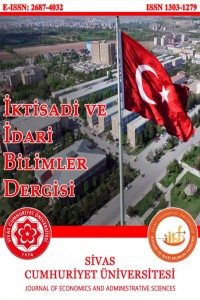Öz
Petrol gelirleri İran ekonomisi açısından büyük önem
arz etmektedir. İran’ın toplam devlet gelirlerinin %60’a yakınını ve ihracatın
yaklaşık %90’lık kısmını petrol ve gaz gelirleri oluşturmaktadır. İran’a
uygulanan ambargolar ticari faaliyetlerini önemli oranda sınırlandırmış, 2008
sonrasında petrol fiyatlarında yaşanan düşüşler de İran’ın gelirlerini
azaltmıştır. Bu kapsamda, çalışmanın amacı petrol gelirleriyle milli gelir arasındaki
uzun dönem ilişkinin tespit edilmesidir. 1964-2016 dönemine ait veriler ele
alınarak, değişkenler arasındaki ilişki ARDL sınır testi yöntemiyle araştırılmıştır.
Petrol gelirlerinin ekonomik büyüme üzerinde uzun dönemli etkisi olduğu teorik
olarak kabul edilmiştir. Elde edilen sonuçlara göre petrol gelirlerinin büyüme
üzerinde uzun dönemde etkin olduğu saptanmıştır.
Anahtar Kelimeler
Kaynakça
- Barro, R. J. (1990). Government spending in a simple model of endogeneous growth. Journal of political economy, 98(5, Part 2), S103-S125.Bolat, S., Belke, M., & Aras, O. (2011). Türkiye’de İkiz Açık Hipotezinin Geçerliliği: Sınır Testi Yaklaşımı. Maliye Dergisi, (161), 347-364.Boutabba, M. A. (2014). The impact of financial development, income, energy and trade on carbon emissions: Evidence from the Indian economy. Economic Modelling, 40, 33-41. https://doi.org/10.1016/j.econmod.2014.03.005Burney, N. A., Mohaddes, K., Alawadhi, A., & Al-Musallam, M. (2018). The dynamics and determinants of Kuwait’s long-run economic growth. Economic Modelling. https://doi.org/10.1016/j.econmod.2017.12.018Corden, W. M., & Neary, J. P. (1982). Booming sector and de-industrialisation in a small open economy. The economic journal, 92(368), 825-848.Dizaji, S. F. (2012). The effects of oil shocks on government expenditures and government revenues nexus in Iran (as a developing oil-export based economy). ISS Working Paper Series / General Series, 540, 1-41.Dizaji, S. F. (2014). The effects of oil shocks on government expenditures and government revenues nexus (with an application to Iran’s sanctions). Economic Modelling, 40, 299-313. https://doi.org/10.1016/j.econmod.2014.04.012Dizaji, S. F., & Farzanegan, M. R. (t.y.). CESifo Working Paper no. 4620, 39.EIA. (2018, Nisan). Iran - International - U.S. Energy Information Administration (EIA). Geliş tarihi 17 Ekim 2018, gönderen https://www.eia.gov/beta/international/country.php?iso=IRNEngle, R. F., & Granger, C. W. (1987). Co-integration and error correction: representation, estimation, and testing. Econometrica: journal of the Econometric Society, 251-276.Esfahani, H. S., Mohaddes, K., & Pesaran, M. H. (2013). Oil exports and the Iranian economy. The Quarterly Review of Economics and Finance, 53(3), 221-237. https://doi.org/10.1016/j.qref.2012.07.001Esfahani, H. S., Mohaddes, K., & Pesaran, M. H. (2014). An empirical growth model for major oil exporters. Journal of Applied Econometrics, 29(1), 1-21.Farzanegan, M. R. (2011). Oil revenue shocks and government spending behavior in Iran. Energy Economics, 33(6), 1055-1069. https://doi.org/10.1016/j.eneco.2011.05.005Farzanegan, M. R., & Markwardt, G. (2009). The effects of oil price shocks on the Iranian economy. Energy Economics, 31(1), 134-151. https://doi.org/10.1016/j.eneco.2008.09.003Garkaz, M., Azma, F., & Jafari, R. (2012). Relationship between oil revenues and government expenditure using wavelet analysis method: Evidence from Iran, 2, 10.Grier, K. B., & Tullock, G. (1989). An empirical analysis of cross-national economic growth, 1951–1980. Journal of monetary economics, 24(2), 259-276.Hassan, K., & Abdullah, A. (2015). Effect of Oil Revenue and the Sudan Economy: Econometric Model for Services Sector GDP. Procedia - Social and Behavioral Sciences, 172, 223-229. https://doi.org/10.1016/j.sbspro.2015.01.358Ilyas, M., Ahmad, H. K., Afzal, M., & Mahmood, T. (2010). Determinants of manufacturing value added in Pakistan: An application of bounds testing approach to cointegration. Pakistan Economic and Social Review, 209-223.Johansen, S. (1988). Statistical analysis of cointegration vectors. Journal of economic dynamics and control, 12(2-3), 231-254.Johansen, S. (1991). Estimation and hypothesis testing of cointegration vectors in Gaussian vector autoregressive models. Econometrica: Journal of the Econometric Society, 1551-1580.Johansen, S., & Juselius, K. (1990). Maximum likelihood estimation and inference on cointegration—with applications to the demand for money. Oxford Bulletin of Economics and statistics, 52(2), 169-210.Kaczmarski, J., & Baek, J. (2018). On the asymmetric effects of oil price changes on Alaska oil tax revenue. Energy Sources, Part B: Economics, Planning, and Policy, 13(1), 60-65. https://doi.org/10.1080/15567249.2017.1403500Krugman, P. (1987). The narrow moving band, the Dutch disease, and the competitive consequences of Mrs. Thatcher: Notes on trade in the presence of dynamic scale economies. Journal of development Economics, 27(1-2), 41-55.Landau, D. (1983). Government expenditure and economic growth: a cross-country study. Southern Economic Journal, 783-792.Mehrara, M. (2008). The asymmetric relationship between oil revenues and economic activities: The case of oil-exporting countries. Energy Policy, 36(3), 1164-1168. https://doi.org/10.1016/j.enpol.2007.11.004Mehrara, M., Maki, M., & Tavakolian, H. (2010). The relationship between oil revenues and economic growth, using threshold methods (the case of Iran). OPEC Energy Review, 34(1), 1-14.Miller, S. M., & Russek, F. S. (1997). Fiscal structures and economic growth: international evidence. Economic Inquiry, 35(3), 603-613.Mohaddes, K., & Pesaran, M. H. (2013). One Hundred Years of Oil Income and the Iranian Economy: A Curse or a Blessing? (CESifo Working Paper Series No. 4118). CESifo Group Munich. Geliş tarihi gönderen https://ideas.repec.org/p/ces/ceswps/_4118.htmlMohaddes, K., & Pesaran, M. H. (t.y.). CESifo Working Paper no. 4118, 39.Neary, J. P., & Van Wijnbergen, S. (1986). Natural resources and the macroeconomy. Cambridge, MA. US: MIT Press.Olayungbo, D. O., & Adediran, K. A. (2017). Effects of Oil Revenue and Institutional Quality on Economic Growth with an ARDL Approach. Energy and Policy Research, 4(1), 44-54. https://doi.org/10.1080/23815639.2017.1307146Pesaran, M. H., Shin, Y., & Smith, R. J. (1996). Testing for the’Existence of a Long-run Relationship’. Faculty of Economics, University of Cambridge.Pesaran, M. H., Shin, Y., & Smith, R. J. (2001). Bounds testing approaches to the analysis of level relationships. Journal of applied econometrics, 16(3), 289-326.Pesaran, M. H., Shin, Y., & Smith, R. P. (1999). Pooled mean group estimation of dynamic heterogeneous panels. Journal of the American Statistical Association, 94(446), 621-634.Reyes-Loya, M. L., & Blanco, L. (2008). Measuring the importance of oil-related revenues in total fiscal income for Mexico. Energy Economics, 30(5), 2552-2568. https://doi.org/10.1016/j.eneco.2008.02.001Sachs, J. D., & Warner, A. M. (1995). Natural resource abundance and economic growth. National Bureau of Economic Research.Van der Ploeg, F. (2011). Natural resources: curse or blessing? Journal of Economic Literature, 49(2), 366-420.
Ayrıntılar
| Birincil Dil | Türkçe |
|---|---|
| Bölüm | Araştırma Makalesi |
| Yazarlar | |
| Yayımlanma Tarihi | 30 Kasım 2019 |
| Gönderilme Tarihi | 22 Ocak 2019 |
| Yayımlandığı Sayı | Yıl 2019 Cilt: 20 Sayı: 2 |
Cumhuriyet Üniversitesi İktisadi ve İdari Bilimler Dergisi Creative Commons Atıf-GayriTicari 4.0 Uluslararası Lisansı (CC BY NC) ile lisanslanmıştır.

